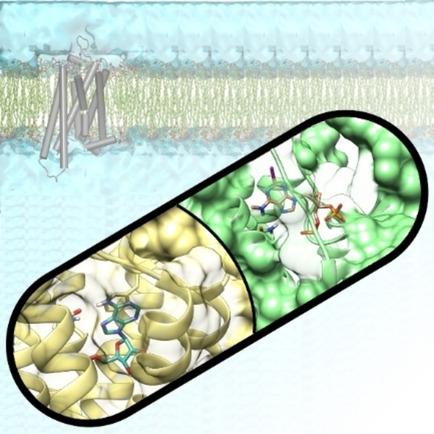当前位置:
X-MOL 学术
›
ChemMedChem
›
论文详情
Our official English website, www.x-mol.net, welcomes your
feedback! (Note: you will need to create a separate account there.)
Purinergic Signaling: Impact of GPCR Structures on Rational Drug Design.
ChemMedChem ( IF 3.6 ) Pub Date : 2020-08-16 , DOI: 10.1002/cmdc.202000465 Veronica Salmaso 1 , Kenneth A Jacobson 1
ChemMedChem ( IF 3.6 ) Pub Date : 2020-08-16 , DOI: 10.1002/cmdc.202000465 Veronica Salmaso 1 , Kenneth A Jacobson 1
Affiliation

|
The purinergic signaling system includes membrane‐bound receptors for extracellular purines and pyrimidines, and enzymes/transporters that regulate receptor activation by endogenous agonists. Receptors include: adenosine (A1, A2A, A2B, and A3) and P2Y (P2Y1, P2Y2, P2Y4, P2Y6, P2Y11, P2Y12, P2Y13, and P2Y14) receptors (all GPCRs), as well as P2X receptors (ion channels). Receptor activation, especially accompanying physiological stress or damage, creates a temporal sequence of signaling to counteract this stress and either mobilize (P2Rs) or suppress (ARs) immune responses. Thus, modulation of this large signaling family has broad potential for treating chronic diseases. Experimentally determined structures represent each of the three receptor families. We focus on selective purinergic agonists (A1, A3), antagonists (A3, P2Y14), and allosteric modulators (P2Y1, A3). Examples of applying structure‐based design, including the rational modification of known ligands, are presented for antithrombotic P2Y1R antagonists and anti‐inflammatory P2Y14R antagonists and A3AR agonists. A3AR agonists are a potential, nonaddictive treatment for chronic neuropathic pain.
中文翻译:

嘌呤能信号传导:GPCR 结构对合理药物设计的影响。
嘌呤能信号系统包括细胞外嘌呤和嘧啶的膜结合受体,以及通过内源性激动剂调节受体激活的酶/转运蛋白。受体包括:腺苷(A 1、A 2A、A 2B和 A 3)和 P2Y(P2Y 1、P2Y 2、P2Y 4、P2Y 6、P2Y 11、P2Y 12、P2Y 13和 P2Y 14)受体(所有 GPCR) )以及 P2X 受体(离子通道)。受体激活,特别是伴随着生理应激或损伤,会产生一系列信号传导的时间序列来抵消这种应激,并动员(P2R)或抑制(AR)免疫反应。因此,调节这个大信号家族在治疗慢性疾病方面具有广泛的潜力。实验确定的结构代表了三个受体家族中的每一个。我们专注于选择性嘌呤能激动剂(A 1、A 3)、拮抗剂(A 3、P2Y 14)和变构调节剂(P2Y 1、A 3)。介绍了抗血栓 P2Y 1 R 拮抗剂、抗炎 P2Y 14 R 拮抗剂和 A 3 AR 激动剂应用基于结构的设计的示例,包括对已知配体的合理修饰。A 3 AR 激动剂是治疗慢性神经性疼痛的一种潜在的、非成瘾性的治疗方法。
更新日期:2020-08-16
中文翻译:

嘌呤能信号传导:GPCR 结构对合理药物设计的影响。
嘌呤能信号系统包括细胞外嘌呤和嘧啶的膜结合受体,以及通过内源性激动剂调节受体激活的酶/转运蛋白。受体包括:腺苷(A 1、A 2A、A 2B和 A 3)和 P2Y(P2Y 1、P2Y 2、P2Y 4、P2Y 6、P2Y 11、P2Y 12、P2Y 13和 P2Y 14)受体(所有 GPCR) )以及 P2X 受体(离子通道)。受体激活,特别是伴随着生理应激或损伤,会产生一系列信号传导的时间序列来抵消这种应激,并动员(P2R)或抑制(AR)免疫反应。因此,调节这个大信号家族在治疗慢性疾病方面具有广泛的潜力。实验确定的结构代表了三个受体家族中的每一个。我们专注于选择性嘌呤能激动剂(A 1、A 3)、拮抗剂(A 3、P2Y 14)和变构调节剂(P2Y 1、A 3)。介绍了抗血栓 P2Y 1 R 拮抗剂、抗炎 P2Y 14 R 拮抗剂和 A 3 AR 激动剂应用基于结构的设计的示例,包括对已知配体的合理修饰。A 3 AR 激动剂是治疗慢性神经性疼痛的一种潜在的、非成瘾性的治疗方法。











































 京公网安备 11010802027423号
京公网安备 11010802027423号